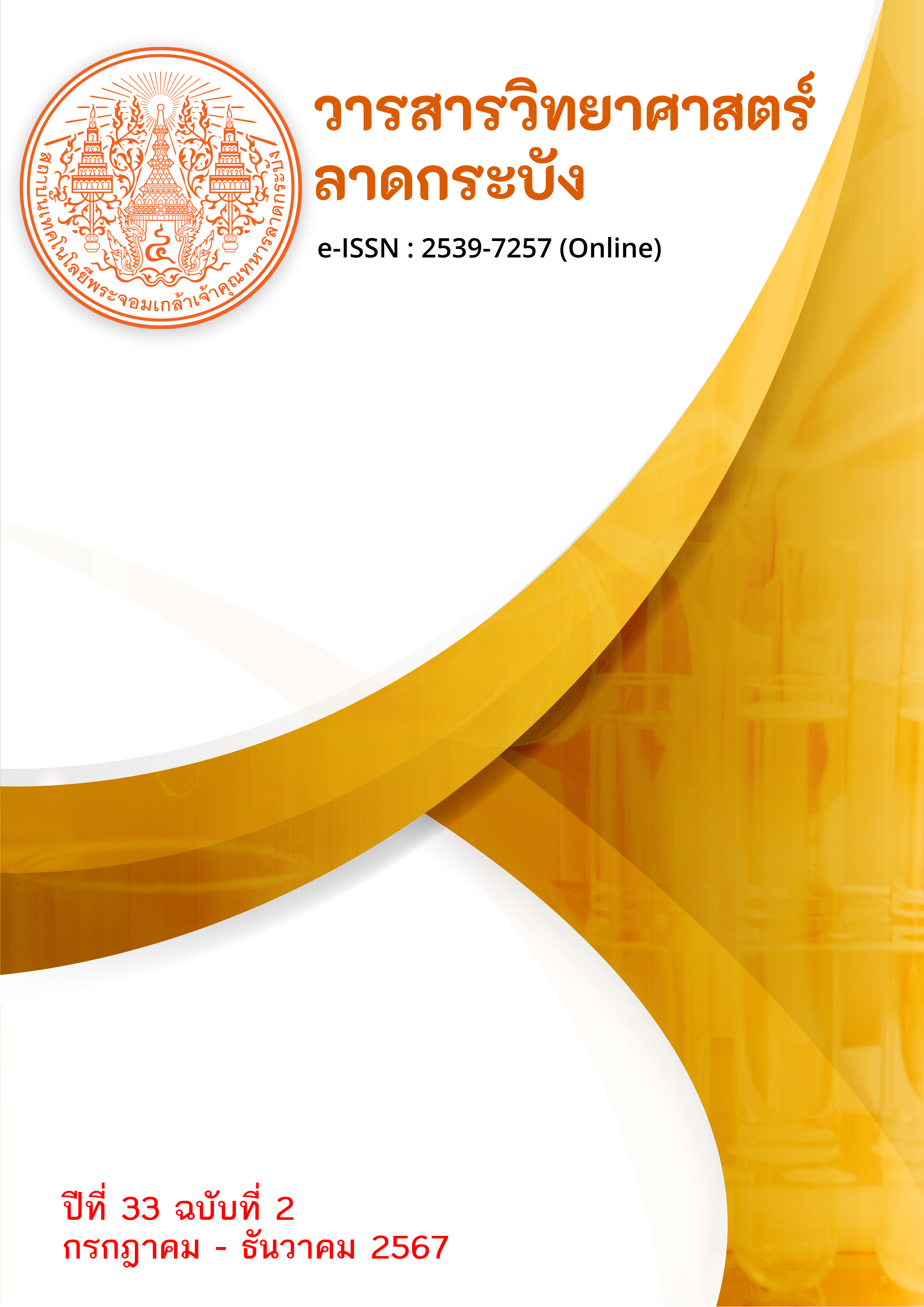การดูดซับสีย้อมอย่างรวดเร็วโดยใช้ผงถ่านคาร์บอนที่ได้จากวัสดุเหลือทิ้งทางการเกษตรจากมะพร้าวในพื้นที่ตำบลบางตลาด จังหวัดฉะเชิงเทรา
Main Article Content
บทคัดย่อ
งานวิจัยนี้มุ่งเน้นการกำจัดสีย้อมที่ปนเปื้อนจากอุตสาหกรรมสิ่งทอที่ส่งผลต่อสุขภาพและสิ่งแวดล้อม การศึกษานี้มีจุดมุ่งหมายเพื่อศึกษาประสิทธิภาพของวัสดุดูดซับสีย้อมจากถ่านคาร์บอนที่เผาจากวัสดุเหลือทิ้งที่มีต้นทุนต่ำผ่านกระบวนการคาร์บอไนเซชันขั้นตอนเดียว เตรียมถ่านจากวัสดุเหลือทิ้งจากเปลือกมะพร้าว กะลามะพร้าวอ่อน และกะลามะพร้าวแก่ โดยการเผาถ่านในเตาเผาแนวตั้งขนาด 200 ลิตร ที่อุณหภูมิ 600 องศาเซลเซียส เป็นเวลา 4 ชั่วโมง ทำการศึกษาลักษณะเฉพาะของถ่านคาร์บอนจากเปลือกมะพร้าว กะลามะพร้าวอ่อน และกะลามะพร้าวแก่ โดยเปรียบเทียบกับผงถ่านกัมมันต์เชิงพาณิชย์ และศึกษาลักษณะทางโครงสร้างด้วยเครื่องวิเคราะห์การเลี้ยวเบนของรังสีเอกซ์ (X-ray Diffractometer: XRD) ในขณะที่ตรวจสอบสัณฐานวิทยาและองค์ประกอบของธาตุด้วยกล้องจุลทรรศน์อิเล็กตรอนแบบส่องกราด (Scanning Electron Microscope: SEM) และเครื่องตรวจเอกซเรย์สเปกโทรสโกปีแบบกระจายพลังงาน (Energy Dispersive Spectrometry: EDS) ผลการศึกษาพบว่าผงถ่านคาร์บอนจากวัสดุเหลือทิ้งมีลักษณะทางโครงสร้างสอดคล้องกับลักษณะทางโครงสร้างของคาร์บอนที่มีการจัดเรียงอย่างไม่เป็นระเบียบเช่นเดียวกันกับโครงสร้างของผงถ่านกัมมันต์เชิงพาณิชย์ ลักษณะทางสัณฐานวิทยาของผงถ่านคาร์บอนจากเปลือกมะพร้าว กะลามะพร้าวอ่อน กะลามะพร้าวแก่ และผงถ่านกัมมันต์เชิงพาณิชย์ พบว่าขนาดรัศมีรูพรุนเฉลี่ยมีค่า 23.45±0.69, 4.72±0.17, 4.22±0.19 และ N/A ไมโครเมตร ตามลำดับ ผลการวิเคราะห์องค์ประกอบของธาตุพบว่าถ่านจากวัสดุทั้งสามตัวอย่าง มีคาร์บอนและออกซิเจนเป็นองค์ประกอบหลักมีสารเจือปนเล็กน้อยเนื่องจากกระบวนการคาร์บอไนเซชันในปริมาณต่ำกว่าร้อยละ 2.84 โดยน้ำหนัก ผลการศึกษาประสิทธิภาพการดูดซับของสีย้อมเมทิลีนบลูโดยใช้ถ่านเป็นวัสดุดูดซับเปรียบเทียบกับถ่านกัมมันต์เชิงพาณิชย์ในสภาวะปกติ พบว่าเวลาที่ใช้ในการดูดซับที่เหมาะสมคือ 15 นาที โดยผงถ่านคาร์บอนจากกะลามะพร้าวแก่ และถ่านกัมมันต์เชิงพาณิชย์สามารถดูดซับสีย้อมเมทิลีนบลูอย่างมีประสิทธิภาพร้อยละ 94.78 และ 97.38 ตามลำดับ เมื่อคำนวณร้อยละความแตกต่างของประสิทธิภาพการดูดซับสีย้อมต่างกัน 2.70 แสดงถึงประสิทธิภาพการดูดซับใกล้เคียงกันมาก อัตราการลดลงของความเข้มข้นของสีย้อมเมทิลีนบลูต่อหน่วยเวลาในรูปแบบ pseudo-first-order reaction จากสมการของ Lagergren ก็มีค่าใกล้เคียงกัน 0.02968 min-1 เมื่อเปรียบเทียบกับถ่านกัมมันต์เชิงพาณิชย์ 0.03775 min-1 อย่างไรก็ตามในด้านของการใช้ทรัพยากรอย่างคุ้มค่า เน้นการฟื้นฟูสิ่งแวดล้อมในชุมชน โดยเฉพาะในจังหวัดฉะเชิงเทรา อีกทั้งยกระดับวัสดุเหลือทิ้งที่ต้นทุนต่ำในชุมชนประยุกต์ใช้เป็นตัวดูดซับสีย้อมสำหรับการบำบัดน้ำเสีย
Article Details

อนุญาตภายใต้เงื่อนไข Creative Commons Attribution-NonCommercial-NoDerivatives 4.0 International License.
เอกสารอ้างอิง
Yang, J. and Qiu, K. 2010. Preparation of activated carbons from walnut shells via vacuum chemical activation and their application for methylene blue removal. Chemical Engineering Journal, 165(1), 209-217, https://doi.org/10.1016/j.cej.2010.09.019.
Bergna, D., Varila, T., Romar, H. and Lassi, U. 2018. Comparison of the properties of activated carbons produced in one-stage and two-stage processes. Journal of carbon research, 4(3), 1-10, https://doi.org/10.3390/c4030041.
De Souza, C.C. et al. 2022. Activated carbon of Coriandrum sativum for adsorption of methylene blue: Equilibrium and kinetic modeling. Cleaner Materials, 3, 100052, https://doi.org/10.1016/j.clema.2022.100052.
Sujiono, E.H., Zabrian, D., Zharvan, V. and Humairah, N.A. 2022. Fabrication and characterization of coconut shell activated carbon using variation chemical activation for wastewater treatment application. Results in Chemistry, 4, 100291, https://doi.org/10.1016/j.rechem.2022.100291.
Dungani, R., Munawar, S.S., Karliati, T., Malik, J. and Aditiawati, P. 2022. Study of Characterization of activated carbon from coconut shells on various particle scales as filler agent in composite materials. Journal of the Korean Wood Science and Technology, 50(4), 256-271, https://doi.org/10.5658/WOOD.2022.50.4.256.
เจนจิรา ภูริรักษ์พิติกร, กิตติยา ปลื้มใจ, วรินดา เฟื่องชูนุช และ แหลมทอง ชื่นชม. 2022. การเพิ่มประสิทธิภาพ การดูดซับสีย้อมเมทิลลีนบลูในน้ำด้วยถ่านกัมมันต์ที่มีรูพรุนเมโซพอร์จากเหง้ามัน สำปะหลังที่เตรียมด้วยกระบวนการไฮโดรเทอร์มอลคาร์บอไนเซชันแบบหม้อเดียว. วารสาร วิทยาศาสตร์ประยุกต์ กรมวิทยาศาสตร์บริการ, 11(11), 45-56, https://doi.org/10.60136/bas.v11.2022.129. [Jenjira Phuriragpitikhon, Kittiya Pluamjai, Warinda Fuangchoonuch, Laemthong Chuenchom. 2022. Enhancing adsorption efficiency of methylene blue from water using cassava rhizome-derived mesoporous activated carbons prepared via one-pot hydrothermal carbonization. Bulletin of Applied Sciences, Natural Resources and Environment, 1(11), 45-56, https://doi.org/10.60136/bas.v11.2022.129. (in Thai)]
สำนักงานเกษตรและสหกรณ์ จังหวัดฉะเชิงเทรา. 2566. ข้อมูลพื้นฐานของจังหวัดฉะเชิงเทรา. แหล่งข้อมูล : https://www.opsmoac.go.th/chachoengsao-home. ค้นเมื่อวันที่ 18 ตุลาคม2566.
Ramutshatsha-Makhwedzha, D., Mavhungu, A., Moropeng, M.L. and Mbaya, R. 2022. Activated carbon derived from waste orange and lemon peels for the adsorption of methyl orange and methylene blue dyes from wastewater. Heliyon, 8(8), 1-9, https://doi.org/10.1016/j.heliyon.2022.e09930.
Taer, E. et al. 2018. Activated carbon electrode made from coconut husk waste for supercapacitor application. International Journal of Electrochemical Science, 13(12), 12072-12084, https://doi.org/10.20964/2018.12.19.
Mopoung, S. 2008. Surface image of charcoal and activated charcoal from banana peel. Journal of Microscopy Society of Thailand, 22, 15-19.
Husin, H., Abubakar, A., Ramadhani, S., Sijabat, C.F.B. and Hasfita, F. 2018. Coconut husk ash as heterogenous catalyst for biodiesel production from cerbera manghas seed oil. MATEC web of conferences, 197, 09008, https://doi.org/10.1051/matecconf/201819709008.
Satheesh, M., Pugazhvadivu, M., Prabu, B., Gunasegaran, V. and Manikandan, A. 2019. Synthesis and characterization of coconut shell ash. Journal of Nanoscience and Nanotechnology, 19(7), 4123-4128, https://doi.org/10.1166/jnn.2019.16299.
Wang, J. and Guo, X. 2020. Adsorption kinetic models: Physical meanings, applications, and solving methods. Journal of Hazardous materials, 390, 122156, https://doi.org/10.1016/j.jhazmat.2020.122156.
Xie, Z., Guan, W., Ji, F., Song, Z. and Zhao, Y. 2014. Production of biologically activated carbon from orange peel and landfill leachate subsequent treatment technology. Journal of chemistry, 91912, 1-9, http://dx.doi.org/10.1155/2014/491912.
Abbas, M. and Trari, M. 2020. Removal of methylene blue in aqueous solution by economic adsorbent derived from apricot stone activated carbon. Fibers and Polymers, 21(4), 810-820, http://dx.doi.org/10.1007/s12221-020-8630-8.
Jawad, A.H. et al. 2017. Microwave-assisted preparation of mesoporous-activated carbon from coconut (Cocos nucifera) leaf by H3PO4 activation for methylene blue adsorption. Chemical Engineering Communications, 204(10), 1143-1156, https://doi.org/10.1080/00986445.2017.1347565.
Tan, I.A.W., Ahmad, A.L. and Hameed, B.H. 2008. Adsorption of basic dye using activated carbon prepared from oil palm shell: batch and fixed bed studies. Desalination, 225(1-3), 13-28, https://doi.org/10.1016/j.desal.2007.07.005.
Jawad, A.H., Sauodi, M.H., Mastuli, M.S., Aouda, M.A. and Radzun, K.A. 2018. Pomegranate peels collected from fresh juice shop as a renewable precursor for high surface area activated carbon with potential application for methylene blue adsorption. Desalination and Water Treatment, 124(4), 287-296, https://doi.org/10.5004/dwt.2018.22725.
Junlabhut, P., Wattanawikkam, C., Mekprasart, W. and Pecharapa, W. 2018. Effect of Metal (Mn, Co, Zn, Ni) Doping on Structural, Optical and Photocatalytic Properties of TiO2 Nanoparticles Prepared by Sonochemical Method. Journal of Nanoscience and Nanotechnology, 18(10), 7302-7309, https://doi.org/10.1166/jnn.2018.15717.
Ohno, T., Tokieda, K., Higashida, S. and Matsumura, M. 2003. Synergism between rutile and anatase TiO2 particles in photocatalytic oxidation of naphthalene. Applied Catalysis A: General, 244(2), 383-391, https://doi.org/10.1016/S0926-860X(02)00610-5.
Liao, Y. et al. 2012. Controllable synthesis of brookite/anatase/rutile TiO2 nanocomposites and single-crystalline rutile nanorods array. Journal of Materials Chemistry, 22(16), 7937-7944.
Sultana, M., Rownok, M.H., Sabrin, M., Rahaman, M.H. and Alam, S.N. 2022. A review on experimental chemically modified activated carbon to enhance dye and heavy metals adsorption. Cleaner engineering and technology, 6, 1-14, https://doi.org/10.1016/j.clet.2021.100382.
Shafeeyan, M.S., Daud, W.M.A.W., Houshmand, A. and Shamiri, A. 2010. A review on surface modification of activated carbon for carbon dioxide adsorption. Journal of Analytical and Applied Pyrolysis, 89(2), 143-151, https://doi.org/10.1016/j.jaap.2010.07.006.

